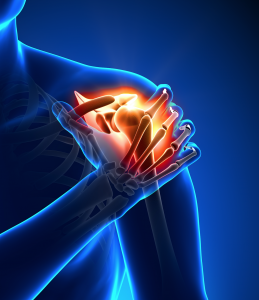glenoid fracture
Part of the shoulder joint, the glenoid bone attaches to the scapula and has a articular cartilage coating. Due to the shallow nature of the bone, the glenoid also has a cartilaginous rim to help seal the humeral head into the cavity to create a secure and mobile joint. While many injuries of the shoulder occur, fractures to the glenoid remain quite uncommon. Glenoid fractures typically result from trauma to the shoulder joint.
Types of glenoid fractures and how to treat
When the Glenoid fractures, it typically fractures in one of two common patterns: Glenoid Lip Fractures or Glenoid Fossa Fractures.
The most common type of glenoid fracture, glenoid lip fractures occur when the ball dislocates from the socket. When the ball dislocates from the socket, it may push against the rim of the glenoid socket, causing a fracture to the bone. Typically, when there is a glenoid lip fracture, doctors opt for surgical intervention.
The second most common glenoid fracture, glenoid fossa fractures, occur in extreme trauma cases to the shoulder. An extremely rare type of fracture, glenoid fossa fractures require a great amount of force. Glenoid fossa fractures affect the center portion of the socket. Due to the rarity of the injury and therefore the rarity of the treatment, the treating physician must assess each individual case and decide how to proceed with treatment. Most patients experiencing a glenoid fossa fracture must undergo surgical intervention.
With any type of glenoid fracture, the shoulder surgeon makes their priority restoring the normal contour of the socket and preventing further injury. While in many cases surgeons resort to surgical treatment, the optimal treatment includes attempting to treat stable glenoid fractures using conservative treatment and unstable fractures using surgical intervention.
Risks of glenoid fracture repair surgery
Like every procedure that punctures the skin, surgery to repair a glenoid fracture has potential risks and complications. Risks pertaining to glenoid fracture surgery include:
- Nerve damage
- Arthritis
- Stiffness of the shoulder joint
- Infection
Patients may also have an allergic reaction to the materials used and should notify their provider of any known allergies.
Following glenoid fracture repair surgery
Following any surgery or treatment for glenoid fractures patients should participate in a physical therapy regimen. A treating physician prescribes a protocol for the patient to strengthen the muscles around the glenoid to prevent additional or future injury of the glenoid socket.
To view a list of all insurances that AOA Orthopedic Specialists accept, click HERE. To schedule an appointment online, click HERE.
CALL OUR 24/7 HOTLINE AT 817-375-5200 TO SCHEDULE AN APPOINTMENT WITH AN ORTHOPEDIC SPECIALIST TODAY!

